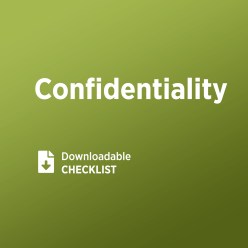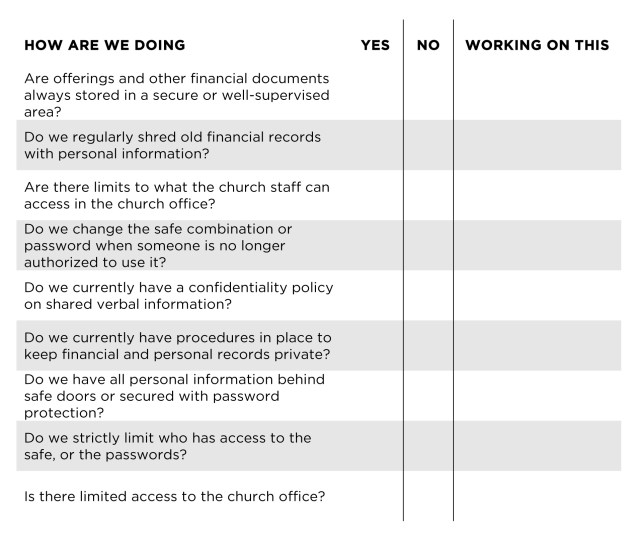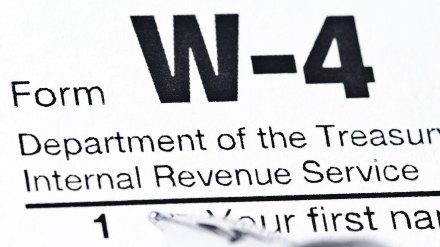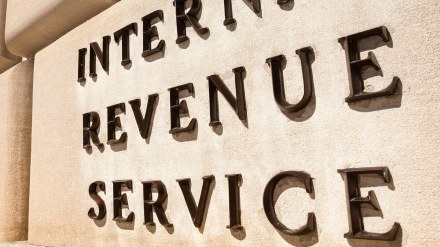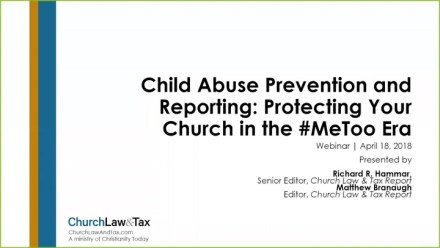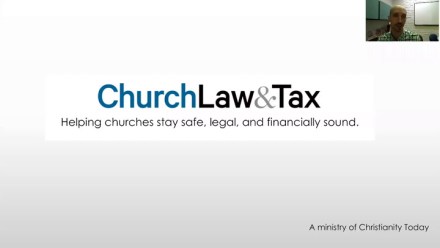For about five years, a financial secretary for a 200-member church quit sending payroll tax money to the Internal Revenue Service.
Instead, she pocketed the funds.
When the IRS came knocking on the church’s door, it owed about $350,000, including penalties and interest, recalled Frank Sommerville, an attorney, CPA, and senior editorial advisor for Church Law & Tax.
“This individual was the sole person in charge of payroll and getting those payroll taxes paid,” Sommerville said. “So the end result was, the church had to sell its property and dissolve to pay the payroll taxes.”
In other cases, it may not be malfeasance that causes a church to neglect payroll taxes, but rather, financial problems within the congregation. Prioritizing the electric bill over the IRS, though, can have dire consequences, Sommerville warned.
A different church had a file folder marked “IRS.” Each time an envelope came in the mail from the IRS, the church would drop it in that folder, said Vonna Laue, a CPA and senior editorial advisor for Church Law & Tax.
A new church treasurer asked about the envelope and was told, “Oh, we’re tax-exempt. We don’t have to worry about anything from the IRS.”
Wrong.
“They had never opened the letters to realize they were notices of failure to file payroll taxes, so penalties and interest accrued really quickly,” Laue said. “Unfortunately, that’s not uncommon, whether they do it willfully or out of ignorance. It can really add up and get expensive in a hurry.”
A common issue for churches
Failure to file payroll taxes on time is a fairly common issue, several experts told Church Law & Tax.
“This is a big problem for smaller churches because they lack sufficient internal controls over the payment of payroll taxes,” Sommerville said. “The church needs to establish numerous checkpoints to assure that the payroll taxes have been paid.”
William Townes, vice president for finance for the Southern Baptist Convention’s executive committee, agreed, adding, “The church treasurer in many smaller churches is usually a volunteer position. Because of this, the volunteer treasurer may simply be unaware or uninformed of tax-filing requirements, which apply to all organizations, and the many consequences of not filing payroll taxes on a timely basis.”
The failure to “withhold and properly remit payroll taxes can include substantial late payment penalties,” Townes warned, “and willful failure to comply can also include felony charges, substantial fines, and possible imprisonment for the person responsible.”
Michael Batts, a CPA and senior editorial advisor for Church Law & Tax, points to two main risk scenarios.
“One is where the payroll processing is done internally by church staff, using the church’s payroll software,” Batts explained, “and the risk is that the person(s) responsible for payroll do not actually remit the payroll taxes to the government.”
The second scenario involves an outside payroll firm. “The church uses an outside payroll processing company to process payroll,” Batts said, “and the church remits the payroll taxes to the processing company, but the processing company doesn’t remit them to the government.”
Both scenarios can carry serious consequences.
“Either scenario is very bad,” Batts said, “and except in very limited circumstances—such as using a certified professional employer organization (CPEO)—the IRS will consider the church to be the employer and will look to the employer for payment, regardless of whether the employer previously remitted the payroll tax funds to a third-party processor.” (For additional information on CPEOs, go to IRS.gov and search “CPEOs.”)
Solving the problem
“An effective way to dramatically reduce this risk is to use a highly reputable and financially sound payroll processing company where the church is required to remit the payroll taxes,” Batts said.
There might be reasons, however, that a church would choose to handle payroll internally. A church might, for instance, have trouble justifying the cost and effort of using a third-party provider.
If that’s the case, a church needs to make sure it has someone on staff who is trained to handle the task and has proper oversight. And there are churches where this is the case, Townes said.
“Similar to many small businesses, many churches and other religious nonprofit organizations are operated by dedicated and competent individuals who correctly administer payroll deposits in accordance with federal rules and regulations,” he said.
But getting correct information about compliance is key. “It requires taking advantage of all available resources and making yourself familiar with the steps to correctly comply,” Townes explained. “This can be done through a host of IRS electronic resources and publications or through the ministries of many denominational organizations that offer publicly available resources for their churches.”
Still, some tax professionals are concerned that a church may unknowingly rely on unqualified internal staff or volunteers to handle payment of payroll taxes.
“Churches certainly can do it themselves, and I have seen some do that, but you really have to understand the competence of the individual involved,” Laue said. “If you’ve got someone who is a volunteer or a staff person for whom this is their job, and they’ve worked payroll for a number of years and understand all the intricacies of it, the person probably can do it and stay on top of it.”
On the other hand, she added, “If it’s someone whose job is to help the youth department and be the receptionist and write the accounts payable checks and, ‘Oh, by the way, you’re responsible for payroll, too,’ that’s probably a disaster waiting to happen.”
If an internal person is handling payroll taxes, then the church board or a business administrator—a committee or individual with financial oversight—needs to be reviewing the quarterly reports to confirm that the taxes were paid, Laue stressed.
Churches that do decide they have the ability to process payroll internally “should implement a ‘dual-control’ process to ensure that at least two approved individuals guarantee taxes are paid properly and on time,” Townes said. “If the church determines that they do not have the consistent expertise to administer payroll properly, they should seek a reputable and qualified third party to administer their organizational payroll.”
“It all goes down to the individual church,” Sommerville added. “More and more, I see my churches using a payroll service.”
Sommerville, though, offers this caveat: the service must be qualified and competent.
As Batts pointed out, some payroll services have been known to not submit the tax payment. “Even when it hires a payroll service, the church is not absolved from liability,” Sommerville stressed. “It has to monitor and supervise the service in order to avoid the adverse consequences.”
A great first step for any church is to have a payroll assessment performed by a knowledgeable CPA or an enrolled agent credentialed by the Internal Revenue Service, Townes urged. “This can help the church verify that everything is being done decently and in order. Or alternatively, it can help identify any issues that need to be corrected.”
Vetting an outside service
If a church does determine it needs to hire an outside company, it needs to do basic fact-checking, Sommerville said: How long has the company been in business? What are its specific areas of expertise? What liability does it assume if something goes wrong? Who are its current clients and references? Does it work with churches specifically or a variety of clients?
Churches can also help protect their sensitive data by working with payroll providers who have service organization controls (SOC) audits and reports.
Some providers have what are known as “Type 2 SOC1” reports, which are independent auditors’ reports on the effectiveness of the internal controls maintained by the company surrounding financial reporting and key operations, Batts said.
“Having a Type 2 SOC1 report is the strongest objectively observable standard for internal control for a payroll processing company,” he added. “In my opinion, a Type 2 SOC1 report with a favorable opinion addressing key controls over financial reporting is a very strong and adequate indicator of a company’s internal control strength.”
Churches, however, cannot simply depend on strong SOC reports. As stressed earlier, churches must have their own effective internal controls in place.
“I am grossly simplifying the point here, but I will say that such reports contain assumptions about controls that users must have in place for the whole process to be sound,” Batts said. “Even if an outside company’s controls are strong, the church must have its own appropriate controls in place in order for the whole process to be sound.”
For Laue, expertise specific to church payrolls is crucial because of special circumstances related to such areas as the ministerial housing allowance and minister tax positions. Payroll services that are not well-versed in such areas should be avoided, she advised.
Also, she recommended talking to current customers, even those on a company’s “official” list of references.
“They’re probably only going to give you satisfied customers,” she said. “But still, when you ask them questions, you can learn a lot.”
Churches should also check with other congregations that use payroll vendors.
Call around and talk to some area churches that currently use a payroll service, recommended Diane Freeman, director of accounting for First Evangelical Free Church of Fullerton, California. The 3,000-member congregation employs 150 people and relies on a payroll service.
“You can do that on your own, rather than asking the company to provide references—because, of course, they’re only going to give you the good ones,” she said. “And it’s the people in the trenches who are actually going to have to work on it and use the program.”
Payroll companies to consider
Stan Reiff, a partner with CapinCrouse, and Sommerville told us about several organizations that work nationally with churches and their bookkeeping, payroll, taxes, and governmental reporting requirements. While by no means exhaustive, these suggestions should give churches options to explore if they are looking for a service provider.
Reiff:
AccuPay. AccuPay is a payroll/HR company that some of our clients use. It is based in the greater Indianapolis area.
BELAY Solutions. We have a lot of churches nationally that use BELAY Solutions for their bookkeeping and payroll processing. This company offers great help especially to smaller and midsize churches. Very proactive with a real passion for its clients.
ChurchShield. ChurchShield is another bookkeeping and payroll company that several of our church clients use that we hear good things about. They have clergy/church payroll/clergy housing/taxation-specific training, and service that makes this company stand out.
Jitasa. Jitasa works with several of our nonprofit groups, which is its specialty. I believe it also serves churches and understands nonprofit accounting and clergy taxation issues. Based out of Idaho, this company works with a lot of federated clients.
Sommerville:
MinistryWorks. Brotherhood Mutual Insurance Company created a separate company that offers payroll-related services. Brotherhood developed this service because it felt like it was dealing with a lot of clients with problems in the payroll area.
Payroll Partners. PSK, a well-known and church-centric CPA firm, created this separate company to provide churches and ministries with payroll services. With 22 years of experience and high client retention rates, this company is popular with many churches.
ADP. This is probably one of the larger, more reputable ones out there. I recommend them for larger churches. If you have three employees, ADP probably isn’t cost-effective. But if you have 50 employees, it is very cost-effective.









